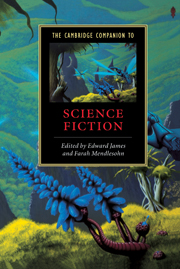Book contents
- Frontmatter
- Introduction
- Part 1 The history
- 1 Science fiction before the genre
- 2 The magazine era: 1926–1960
- 3 New Wave and backwash: 1960–1980
- 4 Science fiction from 1980 to the present
- 5 Film and television
- 6 Science fiction and its editors
- Part 2 Critical approaches
- Part 3 Sub-genres and themes
- Further Reading
- Index
- Series List
4 - Science fiction from 1980 to the present
from Part 1 - The history
Published online by Cambridge University Press: 28 May 2006
- Frontmatter
- Introduction
- Part 1 The history
- 1 Science fiction before the genre
- 2 The magazine era: 1926–1960
- 3 New Wave and backwash: 1960–1980
- 4 Science fiction from 1980 to the present
- 5 Film and television
- 6 Science fiction and its editors
- Part 2 Critical approaches
- Part 3 Sub-genres and themes
- Further Reading
- Index
- Series List
Summary
It is, to begin with, a problem in perception. The nature of sf during the last two decades of the twentieth century can be seen as a classic figure-ground puzzle. One angle of perspective on the era gives us a vision of the triumph of sf as a genre and as a series of outstanding texts which figured to our gaze the significant futures that, during those years, began to come to pass. But under a second angle of perspective, the high profile of sf as a shaping vision becomes indecipherable from the world during these years: in this perspective, sf gradually burned through the categories that gave it the defining potency of genre, and became fatally indistinguishable from the world it attempted to adumbrate, to signify: which is a way of saying, to differ from. Both perspectives, after the nature of figure-ground puzzles, co-exist.
This chapter can be understood to adhere to both perspectives.
Much happened in the two decades between 1980 and 2000. The sf readership broadened and diffused; no longer could it be claimed (a claim only made in any case with any plausibility about some forms of American sf before 1980) that sf was primarily read, or could be profitably written for, adolescent males. Written sf was increasingly presented in the form of books, while magazines declined. Written sf itself lost its unquestioned status as the default form of the genre; indeed, many consumers of sf ideas and iconography now accessed that material solely through film, television and computer gaming, without in fact actually reading sf at all.
- Type
- Chapter
- Information
- The Cambridge Companion to Science Fiction , pp. 64 - 78Publisher: Cambridge University PressPrint publication year: 2003
- 5
- Cited by



